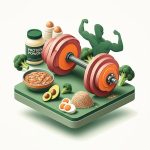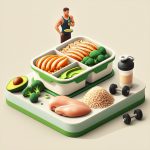You’ve been diligently tracking your calories, hitting the gym, and sticking to your diet plan for three weeks. Yet, the scale hasn’t budged. A frustrating “3 weeks calorie deficit no weight loss” scenario is surprisingly common, and it doesn’t necessarily mean your efforts are in vain. Before you throw in the towel, let’s explore the reasons why you might not be seeing the numbers shift and, more importantly, what you can do about it.
At a Glance:
- Calorie tracking isn’t perfect: Small errors add up.
- Your body adapts: Metabolism slows as you lose weight.
- Beyond the scale: Muscle gain can mask fat loss.
- Lifestyle matters: Sleep and stress impact weight.
- Hormones can play a role: Underlying conditions matter.
The Calorie Deficit: A Quick Refresher
The fundamental principle of weight loss is creating a calorie deficit – consuming fewer calories than your body burns. This forces your body to tap into its stored energy reserves (fat) for fuel. While the concept is simple, the execution can be tricky.
Tracking Troubleshoot: Are You Really in a Deficit?
This is the most common culprit. It’s easy to underestimate calorie intake and overestimate calorie expenditure.
The Underestimation Game: Calories In
Humans are notoriously bad at accurately tracking their food intake. Studies consistently show that people underestimate what they eat. Think about it:
- Hidden Calories: Sauces, dressings, cooking oils, and those “tiny” snacks can pack a caloric punch.
- Portion Distortion: Are you actually measuring your portions, or are you eyeballing it? A handful of nuts can easily be double the recommended serving size.
- Weekend Slippage: Do you diligently track during the week but loosen the reins on weekends? Those extra restaurant meals and treats can quickly negate your weekday efforts.
Solution: - Food Diary or App: Meticulously track everything you eat and drink using a food diary or app like MyFitnessPal.
- Measure, Don’t Guess: Use measuring cups, spoons, and a food scale for accurate portion sizes. Weighing your food, especially items like meat and grains, will significantly improve accuracy. Remember to weigh cooked versus raw if necessary.
- Be Honest: Don’t conveniently “forget” that handful of chips or the extra creamer in your coffee. Those small indulgences can add up.
Overestimating Burn: Calories Out
Fitness trackers and online calculators are helpful tools, but they’re not foolproof. They often overestimate calorie expenditure, sometimes by as much as 20-50%.
Solution:
- Multiple Estimates: Use several different calculators to estimate your daily calorie needs and activity level.
- Don’t “Eat Back” Exercise Calories: Avoid automatically adding back the calories your tracker says you burned during a workout. Consider it a buffer rather than a license to overeat.
- Focus on Trends, Not Absolutes: Use your tracker to identify trends in your activity levels, rather than relying on precise calorie burn numbers.
Metabolic Adaptation: Your Body Is Smart (and Stubborn)
As you lose weight, your body adapts. It requires fewer calories to function, meaning the calorie deficit that initially worked so well becomes less effective. This is sometimes known as adaptive thermogenesis. This can be especially frustrating if you’ve been consistently dieting and why am i not losing.
The BMR Slowdown
Your Basal Metabolic Rate (BMR) – the number of calories your body burns at rest – decreases as you lose weight. A smaller body simply needs less energy to survive.
NEAT Decline
Non-Exercise Activity Thermogenesis (NEAT) – the calories you burn from everyday activities like fidgeting, walking around, and doing chores – can also decrease. Your body unconsciously tries to conserve energy.
Solution:
- Reassess and Adjust: Regularly recalculate your calorie needs every few weeks as you lose weight.
- Increase NEAT: Find ways to incorporate more movement into your daily routine: take the stairs, walk during your lunch break, or invest in a standing desk.
- Strength Training: Building muscle mass increases your BMR, helping you burn more calories at rest.
The Dreaded Plateau: Breaking Through the Wall
A weight loss plateau is a period where weight loss stalls despite continued adherence to your diet and exercise plan. It’s a common experience, and it doesn’t mean you’re failing. It simply means your body has adapted, and you need to shake things up.
Solution:
- Increase Physical Activity: Add an extra workout session, increase the intensity of your workouts, or try a new activity.
- Strength Training: If you’re not already lifting weights, start now. Muscle is metabolically active, meaning it burns more calories than fat, even at rest.
- Vary Your Routine: Your body adapts to repetitive workouts. Try a different form of cardio, change your weightlifting routine, or incorporate interval training.
Lifestyle Factors: The Unsung Heroes (and Villains)
Weight loss isn’t just about calories in and calories out. Lifestyle factors like sleep and stress can significantly impact your progress.
Sleep Deprivation: A Recipe for Cravings
Lack of sleep disrupts hormones that regulate hunger and appetite, leading to increased cravings and calorie intake. When you’re tired, your body craves quick energy, often in the form of sugary and processed foods.
Solution:
- Prioritize Sleep: Aim for 7-9 hours of quality sleep each night. Create a relaxing bedtime routine and stick to a consistent sleep schedule, even on weekends.
Chronic Stress: Cortisol’s Revenge
Chronic stress elevates cortisol levels, a hormone that promotes fat storage, particularly around the abdomen. Stress can also lead to emotional eating and poor food choices.
Solution:
- Stress-Reducing Activities: Practice stress-reducing activities like meditation, yoga, deep breathing exercises, or spending time in nature.
- Address the Source: Identify the sources of stress in your life and find healthy ways to manage them.
Dietary Composition: It’s Not Just About Calories
The types of foods you eat also play a crucial role in weight loss.
Protein Power: Preserving Muscle
Insufficient protein intake can lead to muscle loss, which reduces your metabolism. Protein also helps you feel fuller for longer, reducing overall calorie intake.
Solution:
- Protein at Every Meal: Include a source of protein in every meal, such as lean meats, poultry, fish, eggs, beans, lentils, tofu, or Greek yogurt.
Hydration Habits: Thirst vs. Hunger
Dehydration can be mistaken for hunger, leading to unnecessary calorie consumption.
Solution:
- Drink Plenty of Water: Aim for at least 8 cups (64 ounces) of water daily. Carry a water bottle with you and sip throughout the day.
The “Clean Eating” Trap
Even if you’re eating “clean,” it’s still possible to consume too many calories. Healthy foods like avocados, nuts, and olive oil are calorie-dense and can derail your weight loss efforts if not tracked carefully.
Solution:
- Track Everything: Even healthy foods need to be tracked to ensure you’re staying within your calorie deficit.
Hormonal Influences: When Biology Gets in the Way
Hormonal imbalances can significantly impact metabolism and water retention, making weight loss more challenging.
Menstruation and Menopause
Hormonal fluctuations during menstruation can cause temporary water retention, masking fat loss on the scale. During and after menopause, a calorie deficit but not losing weight is a common complaint due to hormonal shifts and decreased muscle mass.
PCOS and Thyroid Conditions
Women with Polycystic Ovarian Syndrome (PCOS) often find it incredibly difficult to lose weight due to insulin resistance. Hypothyroidism (an underactive thyroid) can slow down your metabolism.
Solution:
- Consult a Doctor: If you suspect a hormonal imbalance, consult your doctor for diagnosis and treatment. Fine-tune your diet based on their recommendations.
- Strength Training: Incorporate weights and strength training into your weekly workouts.
- Prioritize Sleep: Address your sleep hygiene to support hormonal balance.
It’s important to remember that hormonal imbalances can make weight loss harder, but not impossible.
Body Composition Changes: Beyond the Number on the Scale
Weight loss is often associated with a lower number on the scale, but it’s important to consider body composition changes.
Muscle vs. Fat: Density Matters
Gaining muscle while losing fat can maintain or even increase your weight, as muscle is denser than fat. You might be getting smaller and leaner, even if the scale isn’t reflecting it.
Solution:
- Focus on Body Composition: Instead of solely relying on the scale, focus on changes in body composition. Use body composition scans, take measurements, and track progress photos.
- Clothing Fit: Pay attention to how your clothes fit. Are they looser? This is a great indicator of fat loss.
Unrealistic Expectations: Patience Is a Virtue
Weight loss is not always linear. You’ll likely experience fluctuations due to water retention, digestive issues, and other factors. Don’t get discouraged by temporary setbacks.
Solution:
- Long-Term Trends: Focus on long-term trends rather than daily or weekly fluctuations.
- Non-Scale Victories: Celebrate non-scale victories like improved energy levels, better sleep, and increased strength.
- Realistic Goals: Aim for a sustainable rate of weight loss, around 1% of your current body weight per week.
Medical Conditions and Medications: Potential Roadblocks
Certain medical conditions (e.g., Cushing’s syndrome) and medications (e.g., antidepressants, steroids) can hinder weight loss.
Solution:
- Consult a Doctor: Rule out any underlying medical conditions or medication side effects that might be interfering with your weight loss efforts.
The Over-Exercise Myth: More Isn’t Always Better
While exercise is crucial, overdoing it can backfire.
Catabolic State
Excessive cardio can push your body into a catabolic state, where it starts breaking down muscle tissue for energy.
Hunger Stimulation
Exercise stimulates hunger, so your workout might actually be taking you out of a deficit if it leads to overeating.
Solution:
- Don’t Overexercise: Treat working out as a way to assist your weight loss efforts, rather than the primary driver.
- Balanced Approach: Combine cardio with strength training and prioritize recovery.
Calorie Deficit Guidelines: Finding the Sweet Spot
Creating a sustainable calorie deficit is key.
Safe Deficit
A safe starting point is a 500-calorie deficit per day.
Deficit Range
Aim for a deficit of 500 to 1,000 calories per day for healthy and sustainable weight loss.
Too Much
Cutting more than 1,000 calories per day can be detrimental to your health and unsustainable in the long run.
Minimum Intake
- Women: 1,000 to 1,200 calories
- Men: 1,200 to 1,600 calories
When to Seek Professional Help: Don’t Go It Alone
If you’ve tried everything and still aren’t seeing results, consider seeking professional help.
- Medical Intervention: Rule out any underlying medical conditions that might be inhibiting your weight loss efforts.
- Registered Dietitian or Weight Loss Specialist: A professional can create a personalized plan tailored to your specific needs and circumstances. They can also provide guidance and support to help you stay on track. Possible Options: Calorie Deficit, Weight Gain? can be scary, so having an expert can help.
Bottom Line: Persistence and Patience Are Key.
Experiencing “3 weeks calorie deficit no weight loss” can be demoralizing, but it’s important to remember that weight loss is a complex process. Consistent and accurate tracking, understanding metabolic changes, addressing lifestyle factors, and seeking professional help when needed are crucial for success. Don’t give up! Keep making healthy choices, and eventually, you’ll see the results you’re looking for. If you feel like you are doing everything right, and are still struggling, why am i not losing then it may be time to seek out professional help.
- Gluten Free Meal Prep Ideas for Delicious, Hassle-Free Eating - November 28, 2025
- Gluten Free Meal Prep for Stress-Free and Healthy Eating - November 27, 2025
- Quick And Easy Chicken Thigh Meal Prep For Weight Loss - November 26, 2025










